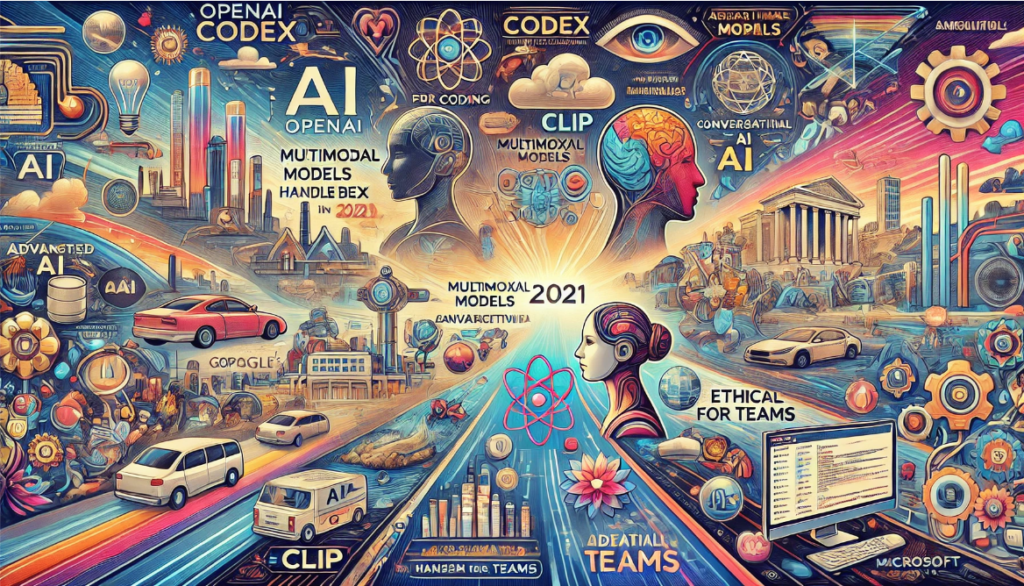End of 2021: Notable Events in AI and LLM Development
As CEO of Conversica, an AI company providing automation for marketing, sales, and customer success teams, the end of 2021 presents so much possibility. This year I have been witnessing a dynamic and rapidly evolving AI landscape. Several significant events and advancements are shaping the field, with LLM developers continuing to push the boundaries of what artificial intelligence can achieve. Here are some of the notable highlights from 2021:
1. Introduction of Codex by OpenAI (July 2021):
OpenAI introduced Codex, a descendant of GPT-3, designed to understand and generate code. Codex powers GitHub Copilot, an AI-powered code completion tool that assists developers by suggesting code snippets and entire functions, significantly enhancing productivity and lowering the barrier to entry for new programmers.
2. Advances in Multimodal Models:
2021 saw significant progress in multimodal AI models that can process and generate content across text, image, and audio data. OpenAI’s CLIP (Contrastive Language-Image Pretraining) and DALL-E models demonstrated remarkable capabilities in understanding and generating images from textual descriptions, highlighting the potential for AI to bridge different types of data seamlessly.
3. Google’s LaMDA (Language Model for Dialogue Applications):
Google announced LaMDA, an advanced conversational AI model designed to engage in open-ended dialogue. Unlike traditional chatbots, LaMDA can sustain more natural and free-flowing conversations, marking a significant step forward in conversational AI.
4. Microsoft’s Mesh for Teams:
Microsoft introduced Mesh for Teams, a mixed reality platform powered by AI that allows users to create virtual avatars and collaborate in a shared virtual space. This innovation leverages AI to enhance remote collaboration, blending the physical and digital worlds.
5. Facebook’s AI Research Developments with M2M-100:
Facebook AI Research (FAIR) continued to make strides in language models and other AI areas. Their work on models like M2M-100, a multilingual machine translation model, enabled translation between any pair of 100 languages without relying on English as an intermediary, showcasing advancements in language translation and global communication.
6. AI for Climate Change and Environmental Monitoring:
AI applications for addressing climate change gained traction in 2021 (see below). Researchers and organizations used AI to model climate patterns, optimize energy usage, and monitor environmental changes. These efforts highlighted the role of AI in tackling some of the most pressing global challenges.
7. Ethical AI and Regulatory Developments:
The ethical implications of AI continued to be a focal point (see below), with increased efforts to develop guidelines and regulations to ensure responsible AI deployment. The European Union proposed the AI Act, a comprehensive regulatory framework aimed at ensuring AI technologies are developed and used responsibly and ethically.
8. NLP and Healthcare Innovations:
The healthcare sector saw notable AI advancements (see below), particularly in natural language processing. AI models were used to analyze medical records, assist in diagnostics, and streamline administrative tasks. These innovations aimed to improve patient care and operational efficiency in healthcare.
9. AI in Creative Arts:
AI’s role in creative arts expanded (see below), with artists and musicians leveraging AI tools to compose music, generate visual art, and create new forms of media. This intersection of AI and creativity opened up novel possibilities for artistic expression.
10. Collaborations and Open Research:
Collaboration and open research continued to be key themes in the AI community (see below). Platforms like Hugging Face and collaborations among leading research institutions facilitated the sharing of models, datasets, and research findings, accelerating the pace of AI innovation.
At the end of 2021, the AI landscape is characterized by rapid advancements, interdisciplinary collaboration, and a strong focus on ethical and responsible AI development. As the CEO of Conversica, I am navigating an exciting era where AI technologies are transforming industries, enhancing human capabilities, and addressing global challenges. The developments of 2021 set the stage for even more groundbreaking innovations in the years to come.
AI for Climate Change and Environmental Monitoring in 2021
In 2021, AI technologies made significant strides in addressing climate change and enhancing environmental monitoring. Here are some notable developments and applications in this domain:
1. Climate Modeling and Prediction:
AI-powered models improved the accuracy of climate predictions by analyzing vast amounts of data from satellite images, weather stations, and climate sensors. Machine learning algorithms helped in understanding complex climate patterns and predicting extreme weather events, aiding in better preparedness and response strategies.
2. Renewable Energy Optimization:
AI was used to optimize the performance of renewable energy sources such as wind, solar, and hydroelectric power. Machine learning algorithms helped in forecasting energy production, managing energy storage systems, and improving the efficiency of energy grids, leading to more reliable and sustainable energy solutions.
3. Carbon Footprint Reduction:
AI played a crucial role in monitoring and reducing carbon footprints across various industries. By analyzing data on energy consumption, emissions, and production processes, AI systems provided insights and recommendations for reducing greenhouse gas emissions and improving energy efficiency.
4. Environmental Monitoring:
AI technologies were deployed to monitor ecosystems and track environmental changes. For example, AI algorithms analyzed satellite imagery and drone footage to detect deforestation, illegal mining activities, and changes in land use. These insights were vital for conservation efforts and policy-making.
5. Wildlife Conservation:
AI was used to protect endangered species and monitor wildlife populations. Machine learning models analyzed audio recordings and camera trap images to identify animal species, track their movements, and detect poaching activities. These technologies helped conservationists make informed decisions and take timely actions to protect wildlife.
6. Agriculture and Food Security:
AI contributed to sustainable agriculture practices by optimizing crop management and reducing resource usage. Precision agriculture techniques, powered by AI, enabled farmers to monitor soil health, predict pest outbreaks, and manage water resources efficiently. These advancements helped in increasing crop yields and ensuring food security.
7. Air Quality Monitoring:
AI systems were employed to monitor air quality in real-time and predict pollution levels. By analyzing data from air quality sensors and meteorological information, AI models provided insights into pollution sources and helped authorities take measures to improve air quality and public health.
8. Water Management:
AI technologies enhanced water management practices by predicting water demand, monitoring water quality, and managing water distribution systems. Machine learning algorithms helped in detecting leaks, optimizing irrigation schedules, and ensuring the efficient use of water resources.
9. Disaster Response and Mitigation:
AI was instrumental in disaster response and mitigation efforts. Predictive models analyzed data from natural disasters such as hurricanes, floods, and wildfires to provide early warnings and assess the impact. AI-powered drones and robots were also used in search and rescue operations, making disaster response more effective and efficient.
The integration of AI in climate change and environmental monitoring in 2021 demonstrated the potential of technology to drive sustainable practices and mitigate the impact of human activities on the environment. These advancements underscored the importance of AI as a tool for addressing some of the most pressing global challenges.
Ethical AI and Regulatory Developments in 2021
In 2021, the ethical implications of artificial intelligence and the need for robust regulatory frameworks gained significant attention. As AI technologies became more pervasive and powerful, ensuring that these technologies were developed and deployed responsibly became a priority for policymakers, researchers, and industry leaders. Here are some of the key developments and trends in ethical AI and regulatory frameworks in 2021:
1. AI Ethics Guidelines and Frameworks:
Numerous organizations and governments published guidelines and frameworks to promote the ethical development and use of AI. These guidelines addressed issues such as transparency, accountability, fairness, and privacy. The aim was to create a set of principles that could guide AI practitioners in building systems that are ethical and beneficial to society.
2. European Union AI Act:
The European Union proposed the AI Act, one of the most comprehensive regulatory frameworks for artificial intelligence. The AI Act aimed to regulate AI technologies based on their risk levels, categorizing them into high-risk, limited-risk, and minimal-risk applications. High-risk AI systems, such as those used in critical infrastructure, healthcare, and law enforcement, would be subject to stringent requirements to ensure their safety and reliability.
3. Banning Harmful AI Applications:
Some jurisdictions took steps to ban or restrict certain AI applications deemed harmful or unethical. For example, there were increasing calls to ban AI-based facial recognition technology in public spaces due to concerns about privacy and mass surveillance. Several cities and countries implemented or proposed bans on this technology to protect citizens’ rights.
4. AI Transparency and Explainability:
The demand for AI transparency and explainability grew in 2021. Stakeholders emphasized the importance of making AI systems understandable to users, regulators, and the public. Techniques such as explainable AI (XAI) aimed to provide insights into how AI models make decisions, ensuring that these systems could be trusted and held accountable.
5. Bias and Fairness in AI:
Addressing bias and ensuring fairness in AI systems remained a critical focus. Researchers and developers worked on identifying and mitigating biases in training data and algorithms to prevent discriminatory outcomes. Tools and methodologies for auditing AI systems for bias were developed, promoting fairness and equity in AI applications.
6. Data Privacy and Security:
Data privacy and security were paramount concerns, particularly with AI systems that rely on vast amounts of personal data. Regulations like the General Data Protection Regulation (GDPR) in Europe set high standards for data protection. Organizations needed to ensure that their AI systems complied with these regulations, protecting users’ privacy and securing sensitive information.
7. Global Collaboration and Standards:
There was a growing recognition of the need for international collaboration in AI governance. Organizations like the OECD (Organisation for Economic Co-operation and Development) and UNESCO (United Nations Educational, Scientific and Cultural Organization) worked on establishing global standards and principles for AI ethics. These efforts aimed to harmonize regulatory approaches and promote responsible AI development worldwide.
8. Industry Self-Regulation:
Many AI companies and industry groups took proactive steps towards self-regulation. Initiatives such as the Partnership on AI, involving major tech companies and research institutions, aimed to establish best practices and ethical standards for AI. Companies also formed internal ethics boards and advisory panels to oversee their AI projects.
9. Public Awareness and Engagement:
Public awareness of AI ethics increased, with more discussions and debates about the societal impact of AI technologies. Public engagement initiatives, such as AI ethics workshops, conferences, and forums, provided platforms for diverse stakeholders to voice their concerns and contribute to shaping ethical AI policies.
The focus on ethical AI and regulatory developments in 2021 reflected a growing understanding that while AI has the potential to bring about significant benefits, it must be guided by strong ethical principles and regulatory oversight to ensure that it serves the public good and upholds fundamental rights and values.
NLP and Healthcare Innovations in 2021
In 2021, natural language processing (NLP) made significant strides in the healthcare sector, offering innovative solutions to improve patient care, streamline administrative tasks, and enhance medical research. Here are some of the key developments and applications of NLP in healthcare during that year:
1. Medical Record Analysis:
NLP technologies were increasingly used to analyze electronic health records (EHRs). These systems could extract valuable insights from unstructured data, such as clinical notes, lab reports, and radiology findings. By processing and interpreting this data, NLP tools helped healthcare providers make more informed decisions, identify trends, and improve patient outcomes.
2. Clinical Decision Support:
NLP-powered clinical decision support systems (CDSS) provided healthcare professionals with evidence-based recommendations at the point of care. These systems analyzed patient data and medical literature to offer diagnostic suggestions, treatment options, and potential drug interactions, enhancing the accuracy and efficiency of clinical decision-making.
3. Patient Communication and Engagement:
NLP-driven chatbots and virtual assistants became more sophisticated, enabling better patient communication and engagement. These AI tools could answer patient queries, provide medication reminders, and offer personalized health advice. By automating routine interactions, NLP applications helped reduce the burden on healthcare staff and improve patient satisfaction.
4. Medical Research and Literature Mining:
NLP technologies were used to mine vast amounts of medical literature for research purposes. Automated literature review tools helped researchers stay up-to-date with the latest studies, identify relevant articles, and extract key information. This facilitated faster and more comprehensive research, accelerating the discovery of new treatments and interventions.
5. Voice Recognition and Documentation:
Voice recognition systems powered by NLP were increasingly adopted for medical documentation. These systems transcribed spoken dictations into written text, allowing healthcare providers to document patient encounters more efficiently. This reduced the time spent on paperwork, enabling clinicians to focus more on patient care.
6. Symptom Checkers and Diagnostic Tools:
NLP-enabled symptom checkers and diagnostic tools provided patients with preliminary assessments based on their reported symptoms. By analyzing patient inputs and comparing them with medical knowledge databases, these tools could suggest potential conditions and guide users on whether to seek medical attention.
7. Population Health Management:
NLP played a crucial role in population health management by analyzing large datasets to identify health trends and risks within specific populations. Public health authorities used these insights to design targeted interventions, allocate resources effectively, and monitor the impact of public health initiatives.
8. Sentiment Analysis for Patient Feedback:
Healthcare organizations used NLP for sentiment analysis to gauge patient satisfaction and identify areas for improvement. By analyzing patient reviews, feedback forms, and social media posts, NLP tools helped healthcare providers understand patient experiences and address concerns proactively.
9. Drug Discovery and Pharmacovigilance:
NLP technologies were applied in drug discovery to analyze scientific literature, clinical trial data, and patents. These tools identified potential drug candidates, predicted adverse reactions, and monitored the safety of medications in the market. This accelerated the drug development process and improved patient safety.
10. Telemedicine and Remote Monitoring:
With the rise of telemedicine, NLP was used to enhance remote consultations and patient monitoring. NLP algorithms analyzed patient-reported symptoms and medical histories during virtual visits, providing clinicians with valuable insights. Remote monitoring systems also leveraged NLP to interpret data from wearable devices and alert healthcare providers to potential issues.
The advancements in NLP for healthcare in 2021 demonstrated the technology’s potential to transform various aspects of the healthcare system, making it more efficient, accurate, and patient-centric. By harnessing the power of NLP, healthcare providers were able to deliver better care, improve operational efficiencies, and drive innovation in medical research and practice.
AI in Creative Arts in 2021
In 2021, artificial intelligence continued to make significant inroads into the creative arts, transforming how artists, musicians, writers, and other creatives approached their work. AI tools and technologies enabled new forms of artistic expression, streamlined creative processes, and opened up novel possibilities for collaboration between humans and machines. Here are some notable developments and applications of AI in the creative arts during that year:
1. Generative Art:
AI algorithms, particularly generative adversarial networks (GANs) and neural networks, were used to create stunning and original visual art. Artists and technologists experimented with these models to produce unique paintings, illustrations, and digital artworks. Tools like DeepArt and RunwayML allowed users to generate art based on specific styles or themes, pushing the boundaries of digital creativity.
2. Music Composition:
AI-powered music composition tools gained popularity, enabling musicians to compose new pieces with the help of machine learning algorithms. Platforms like OpenAI’s MuseNet and Jukedeck allowed users to create music across various genres and styles. AI-assisted composition offered new ways to experiment with melodies, harmonies, and rhythms, enhancing the creative process for both amateur and professional musicians.
3. Writing and Storytelling:
Large language models like OpenAI’s GPT-3 were utilized to assist writers in generating text, crafting narratives, and brainstorming ideas. AI tools could help writers overcome writer’s block, suggest plot developments, and create dialogue for characters. These applications provided valuable support for novelists, screenwriters, and content creators, enriching their storytelling capabilities.
4. Film and Animation:
AI technologies were applied in the film and animation industries to streamline production processes and enhance creative outputs. AI-driven tools helped with tasks such as script analysis, storyboarding, and special effects. In animation, AI algorithms could automate certain aspects of character movement and scene generation, making the production process more efficient.
5. Interactive and Immersive Experiences:
AI played a significant role in creating interactive and immersive experiences, such as virtual reality (VR) and augmented reality (AR) applications. AI-driven characters and environments responded to user inputs, creating dynamic and engaging experiences. These technologies were used in gaming, virtual art exhibitions, and interactive storytelling, offering new ways for audiences to engage with creative content.
6. Collaborative Art Projects:
AI facilitated collaborative art projects between humans and machines. Artists worked alongside AI systems to co-create pieces, blending human intuition with machine-generated patterns and suggestions. These collaborations resulted in innovative artworks that showcased the potential of human-AI synergy in the creative process.
7. Fashion and Design:
AI was increasingly used in fashion and design to generate new clothing patterns, suggest color palettes, and optimize design processes. Tools like DeepDream and Artbreeder allowed designers to explore creative possibilities by generating unique designs based on input parameters. AI also assisted in trend forecasting and personalized fashion recommendations.
8. Poetry and Literature:
AI-generated poetry and literature gained attention, with models like GPT-3 producing poems, short stories, and even full-length novels. While these AI-generated works sometimes lacked the depth and nuance of human writing, they provided interesting insights into the capabilities of AI in the literary arts and sparked discussions about the future of AI-generated content.
9. Art Restoration and Preservation:
AI technologies were used in art restoration and preservation, helping to analyze and restore damaged artworks. Machine learning algorithms could predict the original colors and patterns of aged or deteriorated pieces, aiding conservators in their restoration efforts. AI also helped in digitizing and cataloging art collections, making them more accessible to the public.
10. Public Engagement and Art Education:
AI-powered applications and platforms engaged the public in new ways, offering interactive art experiences and educational tools. AI-driven virtual galleries and museums allowed users to explore art collections remotely, while educational tools provided insights into artistic techniques and history. These applications made art more accessible and engaging for diverse audiences.
In 2021, AI’s impact on the creative arts was profound, offering new tools and possibilities for artists and creators. By augmenting human creativity with machine intelligence, AI helped to push the boundaries of artistic expression and opened up exciting new frontiers in the world of art and culture.
Collaborations and Open Research in AI in 2021
In 2021, collaborations and open research played a crucial role in advancing the field of artificial intelligence. These efforts fostered innovation, accelerated the dissemination of knowledge, and ensured that AI technologies were developed responsibly and ethically. Here are some notable trends and events in collaborations and open research in AI during 2021:
1. Collaborative AI Research Initiatives:
Major technology companies, academic institutions, and research organizations continued to collaborate on AI research projects. Initiatives like the Partnership on AI, which includes members from academia, industry, and civil society, worked on addressing important issues such as fairness, transparency, and accountability in AI.
2. OpenAI’s GPT-3 and API Access:
OpenAI continued to expand access to its GPT-3 model through an API, allowing developers, researchers, and businesses to experiment with and build on top of this powerful language model. This open access facilitated a wide range of applications and research projects, fostering innovation across various domains.
3. Hugging Face and the Transformers Library:
Hugging Face’s Transformers library remained a pivotal resource for the AI community. The library provided easy access to state-of-the-art models and tools, enabling researchers and developers to share their work and build on existing models. Hugging Face also encouraged collaboration by hosting model competitions and community events.
4. Google’s TensorFlow and JAX:
Google’s TensorFlow and JAX frameworks continued to be widely used in the AI research community. These open-source libraries provided powerful tools for building and experimenting with machine learning models. Google’s support for open research was evident in its contributions to these projects and its collaboration with external researchers.
5. Facebook AI’s Open Research:
Facebook AI Research (FAIR) made significant contributions to open research by publishing their findings and releasing models and datasets to the public. FAIR’s open research initiatives included advancements in natural language processing, computer vision, and other areas, promoting transparency and knowledge sharing in the AI community.
6. AI Ethics and Responsible AI:
Collaborations around AI ethics and responsible AI development gained momentum in 2021. Organizations like the Alan Turing Institute, the IEEE Global Initiative on Ethics of Autonomous and Intelligent Systems, and the Montreal AI Ethics Institute worked together to develop guidelines, best practices, and frameworks to ensure the ethical deployment of AI technologies.
7. COVID-19 Research Collaborations:
The ongoing COVID-19 pandemic spurred numerous collaborative research efforts leveraging AI to combat the virus. Researchers from various institutions used AI to model the spread of the virus, analyze medical data, and accelerate vaccine development. These collaborations highlighted the importance of open data and shared resources in addressing global challenges.
8. Competitions and Challenges:
AI competitions and challenges, such as those hosted by Kaggle, NeurIPS, and other conferences, encouraged collaboration and innovation. These events provided platforms for researchers to tackle specific problems, share their solutions, and advance the state of the art in AI.
9. Interdisciplinary Collaboration:
AI research increasingly involved interdisciplinary collaboration, bringing together experts from fields such as neuroscience, linguistics, economics, and social sciences. These collaborations enriched AI research by incorporating diverse perspectives and addressing complex problems that span multiple domains.
10. Open Data and Datasets:
The availability of open datasets remained critical for AI research. Initiatives like ImageNet, Common Crawl, and others provided valuable resources for training and evaluating machine learning models. Open access to high-quality datasets enabled researchers to conduct experiments and validate their findings on a large scale.
11. Publication and Preprint Platforms:
Preprint platforms like arXiv and bioRxiv continued to be essential for the dissemination of AI research. These platforms allowed researchers to share their work quickly with the community, facilitating rapid feedback and collaboration. The use of open access journals and conferences also promoted transparency and accessibility in AI research.
In 2021, collaborations and open research in AI demonstrated the power of collective efforts in driving technological advancements and addressing societal challenges. By fostering a culture of openness and collaboration, the AI community was able to accelerate innovation, ensure ethical practices, and create impactful solutions for a better future.
See:




